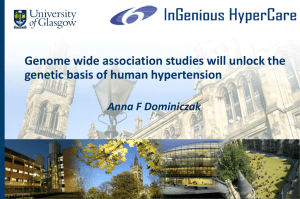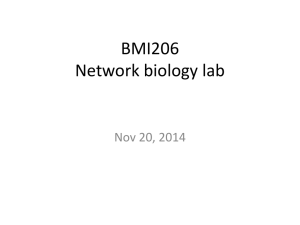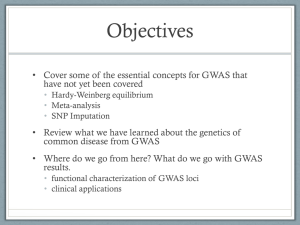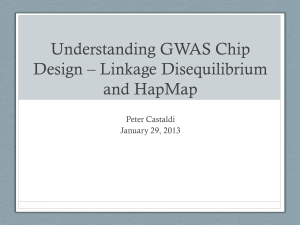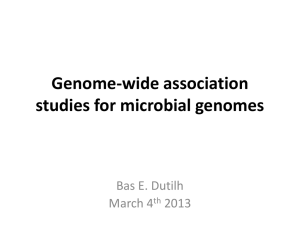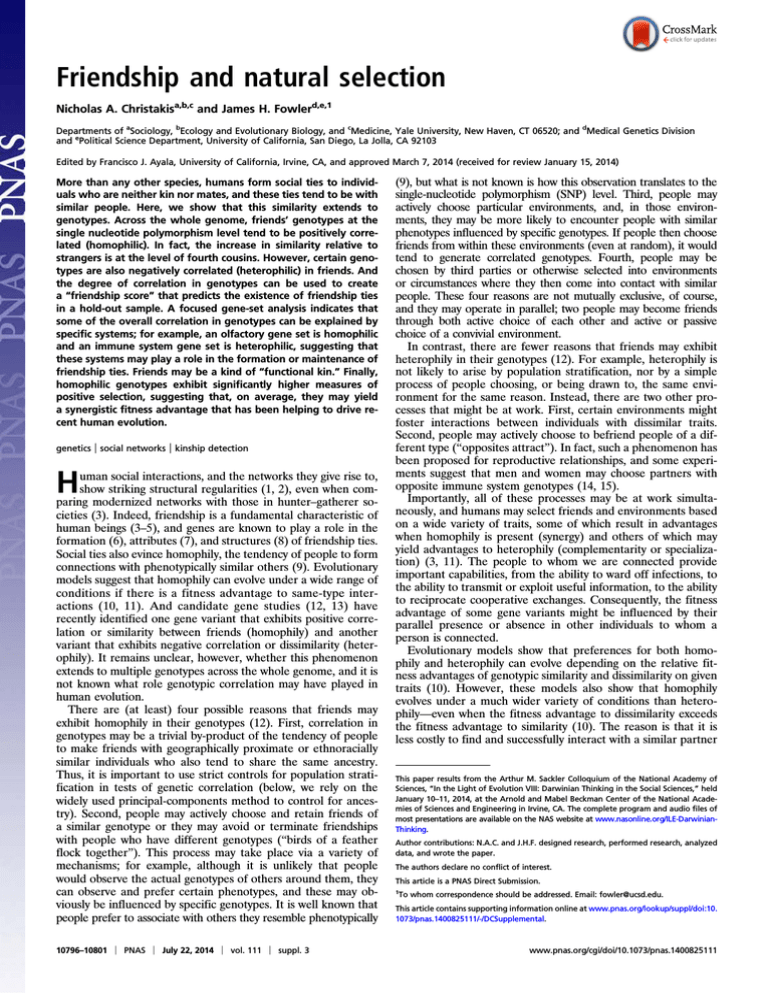
Friendship and natural selection
Nicholas A. Christakisa,b,c and James H. Fowlerd,e,1
Departments of aSociology, bEcology and Evolutionary Biology, and cMedicine, Yale University, New Haven, CT 06520; and dMedical Genetics Division
and ePolitical Science Department, University of California, San Diego, La Jolla, CA 92103
Edited by Francisco J. Ayala, University of California, Irvine, CA, and approved March 7, 2014 (received for review January 15, 2014)
More than any other species, humans form social ties to individuals who are neither kin nor mates, and these ties tend to be with
similar people. Here, we show that this similarity extends to
genotypes. Across the whole genome, friends’ genotypes at the
single nucleotide polymorphism level tend to be positively correlated (homophilic). In fact, the increase in similarity relative to
strangers is at the level of fourth cousins. However, certain genotypes are also negatively correlated (heterophilic) in friends. And
the degree of correlation in genotypes can be used to create
a “friendship score” that predicts the existence of friendship ties
in a hold-out sample. A focused gene-set analysis indicates that
some of the overall correlation in genotypes can be explained by
specific systems; for example, an olfactory gene set is homophilic
and an immune system gene set is heterophilic, suggesting that
these systems may play a role in the formation or maintenance of
friendship ties. Friends may be a kind of “functional kin.” Finally,
homophilic genotypes exhibit significantly higher measures of
positive selection, suggesting that, on average, they may yield
a synergistic fitness advantage that has been helping to drive recent human evolution.
genetics
| social networks | kinship detection
H
uman social interactions, and the networks they give rise to,
show striking structural regularities (1, 2), even when comparing modernized networks with those in hunter–gatherer societies (3). Indeed, friendship is a fundamental characteristic of
human beings (3–5), and genes are known to play a role in the
formation (6), attributes (7), and structures (8) of friendship ties.
Social ties also evince homophily, the tendency of people to form
connections with phenotypically similar others (9). Evolutionary
models suggest that homophily can evolve under a wide range of
conditions if there is a fitness advantage to same-type interactions (10, 11). And candidate gene studies (12, 13) have
recently identified one gene variant that exhibits positive correlation or similarity between friends (homophily) and another
variant that exhibits negative correlation or dissimilarity (heterophily). It remains unclear, however, whether this phenomenon
extends to multiple genotypes across the whole genome, and it is
not known what role genotypic correlation may have played in
human evolution.
There are (at least) four possible reasons that friends may
exhibit homophily in their genotypes (12). First, correlation in
genotypes may be a trivial by-product of the tendency of people
to make friends with geographically proximate or ethnoracially
similar individuals who also tend to share the same ancestry.
Thus, it is important to use strict controls for population stratification in tests of genetic correlation (below, we rely on the
widely used principal-components method to control for ancestry). Second, people may actively choose and retain friends of
a similar genotype or they may avoid or terminate friendships
with people who have different genotypes (“birds of a feather
flock together”). This process may take place via a variety of
mechanisms; for example, although it is unlikely that people
would observe the actual genotypes of others around them, they
can observe and prefer certain phenotypes, and these may obviously be influenced by specific genotypes. It is well known that
people prefer to associate with others they resemble phenotypically
10796–10801 | PNAS | July 22, 2014 | vol. 111 | suppl. 3
(9), but what is not known is how this observation translates to the
single-nucleotide polymorphism (SNP) level. Third, people may
actively choose particular environments, and, in those environments, they may be more likely to encounter people with similar
phenotypes influenced by specific genotypes. If people then choose
friends from within these environments (even at random), it would
tend to generate correlated genotypes. Fourth, people may be
chosen by third parties or otherwise selected into environments
or circumstances where they then come into contact with similar
people. These four reasons are not mutually exclusive, of course,
and they may operate in parallel; two people may become friends
through both active choice of each other and active or passive
choice of a convivial environment.
In contrast, there are fewer reasons that friends may exhibit
heterophily in their genotypes (12). For example, heterophily is
not likely to arise by population stratification, nor by a simple
process of people choosing, or being drawn to, the same environment for the same reason. Instead, there are two other processes that might be at work. First, certain environments might
foster interactions between individuals with dissimilar traits.
Second, people may actively choose to befriend people of a different type (“opposites attract”). In fact, such a phenomenon has
been proposed for reproductive relationships, and some experiments suggest that men and women may choose partners with
opposite immune system genotypes (14, 15).
Importantly, all of these processes may be at work simultaneously, and humans may select friends and environments based
on a wide variety of traits, some of which result in advantages
when homophily is present (synergy) and others of which may
yield advantages to heterophily (complementarity or specialization) (3, 11). The people to whom we are connected provide
important capabilities, from the ability to ward off infections, to
the ability to transmit or exploit useful information, to the ability
to reciprocate cooperative exchanges. Consequently, the fitness
advantage of some gene variants might be influenced by their
parallel presence or absence in other individuals to whom a
person is connected.
Evolutionary models show that preferences for both homophily and heterophily can evolve depending on the relative fitness advantages of genotypic similarity and dissimilarity on given
traits (10). However, these models also show that homophily
evolves under a much wider variety of conditions than heterophily—even when the fitness advantage to dissimilarity exceeds
the fitness advantage to similarity (10). The reason is that it is
less costly to find and successfully interact with a similar partner
This paper results from the Arthur M. Sackler Colloquium of the National Academy of
Sciences, “In the Light of Evolution VIII: Darwinian Thinking in the Social Sciences,” held
January 10–11, 2014, at the Arnold and Mabel Beckman Center of the National Academies of Sciences and Engineering in Irvine, CA. The complete program and audio files of
most presentations are available on the NAS website at www.nasonline.org/ILE-DarwinianThinking.
Author contributions: N.A.C. and J.H.F. designed research, performed research, analyzed
data, and wrote the paper.
The authors declare no conflict of interest.
This article is a PNAS Direct Submission.
1
To whom correspondence should be addressed. Email: fowler@ucsd.edu.
This article contains supporting information online at www.pnas.org/lookup/suppl/doi:10.
1073/pnas.1400825111/-/DCSupplemental.
www.pnas.org/cgi/doi/10.1073/pnas.1400825111
in a population of similar individuals than it is to find and successfully interact with a dissimilar partner in a population of
dissimilar individuals. For an intuition regarding this observation, consider populations at fixation. For populations with an
advantage to homophily, all individuals have the same trait at
fixation, and so they all will gain the advantage in every interaction. In contrast, for populations with an advantage to
heterophily, some individuals have one trait and some have another, meaning there are still likely to be at least some same-type
encounters in the population that do not yield the advantage to
dissimilar-type interactions. These theoretical models thus suggest that we should find more genotypes that are positively
correlated between friends than negatively correlated and that
we should, on average, expect friends to exhibit greater genetic
similarity across the genome as a whole (10).
If homophily generally contributes to evolutionary fitness across
a wide variety of traits, then we would also expect to see signs of
positive selection for genes that exhibit positive correlation between friends. If so, it would suggest that our capacity to make
friends with unrelated strangers may have played a role in human
evolution. This capacity to form friendships and this preference
for homophily [which is also seen in other social animals such as
dolphins (16) and primates (17)] may possibly reflect the extended
workings of a kin detection system (18) such that genetically
similar (but unrelated) friends are a kind of “functional kin.”
Humans may—when choosing friends from among individuals
who are strictly not related to them—come to choose individuals
who do, after all, resemble them on a genotypic level.
Here, we conduct, to our knowledge, the first genome-wide
analysis of correlation in genotypes between friends. We emphasize that we are not conducting a genome-wide association
study (GWAS) of a propensity to be friendly (or some similar
complex social trait); rather, we are using GWAS techniques to
identify certain theorized patterns (10) across the whole genome.
Using data from the Framingham Heart Study, we analyzed
466,608 (unimputed) SNPs in 1,932 unique subjects who are in
one or more of 1,367 friendship pairs (see SI Appendix for data
construction and summary). The data we used (which we have
uploaded to a shared data repository at www.ncbi.nlm.nih.gov/
projects/gap/cgi-bin/study.cgi?study_id=phs000153.v6.p5) are
exceedingly scarce; we know of no other dataset of any significant size that has information on both friendship ties and
common genetic variants across the whole genome (SI Appendix). As a check against false positives, beyond the other procedures described below, we also performed a split-sample
replication study. We also emphasize that, as in other wholegenome investigations with circumscribed samples (19, 20), our
interest is not in any particular SNP, but rather in the pattern
across the whole genome.
To assess general, overall homophily within pairs of friends,
we calculated the kinship coefficient (21) (the probability that
two alleles sampled at random from two individuals are identical
by state), a measure that is equal to half the relatedness measure
used in genome-wide complex trait analysis (GCTA) approaches
(22) (although the pairs of friends here are not actually related).
Positive values for this measure indicate that genotypes are
positively correlated, and negative values indicate that two individuals are not related and, in fact, tend to have opposite genotypes. To measure heterophily, we calculated the empirical
probability that two individuals have opposite genotypes at
a given SNP, measured by the proportion of SNPs for which
neither allele is identical by state.
For comparison, we also calculated these measures for all
nonkin “stranger” pairs using the same set of 1,932 subjects who
are in the friends sample. After removing kin (who can, of course,
be identified using genotyping) and after removing pairs who had
a social relationship (i.e., friends, spouses, etc.), we identified
1,196,429 stranger pairs (SI Appendix). Fig. 1A shows that the
Christakis and Fowler
distribution of kinship coefficients for friends is shifted right relative to the strangers. A simple difference-in-means test suggests
that friends tend to be significantly more genetically “related” than
strangers (+0.0014, P < 2 × 10−16), and, as a benchmark, the size
of the difference roughly corresponds to the kinship coefficient we
would expect for fourth cousins (0.0010). This difference cannot
be explained by the ancestral composition of the sample or by
cryptic relatedness because the same people are used in both the
friends and strangers samples (the only thing that differs is the set
of relationships between them); and we emphasize again that we
can be sure these pairs of friends are not, in fact, distant cousins
because they are strictly unrelated and there is no identity by
descent. Meanwhile, Fig. 1B shows that friends also tend to have
fewer SNPs where the genotypes are exactly opposite (–0.0002,
P = 4 × 10−9). Both of these results indicate that pairs of (strictly
unrelated) friends generally tend to be more genetically homophilic than pairs of strangers from the same population, but the
weaker results for opposite genotypes suggest that this general
tendency toward homophily may be obscuring a tendency for some
specific parts of the genome to be heterophilic.
The results so far do not control for population stratification
because we wanted to characterize overall similarity. However, it
is important to remember that some of the similarity in genotypes can be explained by simple assortment into relationships
with people who have the same ancestral background. The
Framingham Heart Study is composed of mostly whites (e.g., of
Italian descent), so it is possible that a simple preference for
ethnically similar others could explain the results in Fig. 1.
However, in the following results, we applied strict controls for
population stratification to ensure that any correlation we observed was not due to such a process.
To characterize the genotypes that are most likely to be homophilic or heterophilic, we conducted a GWAS regressing subject’s
expected genotype on friend’s expected genotype for 1,468,013
common SNPs (minor allele frequency >0.10; see SI Appendix for
imputation and regression details). For this GWAS analysis, we
used both unimputed and imputed SNPs to improve power, but we
emphasize, again, that our interest here is not in any particular
SNP, but rather in the pattern across the whole genome.
Although the individuals in the Framingham Heart Study are
almost all of European ancestry, population stratification has
been shown to be a concern even in samples of European
Americans (23). Relying on a widely used procedure to control
for population stratification, we calculated the first 10 principal
components of the subject–gene matrix with EIGENSTRAT
(24). None of our subjects are classified as outliers, defined as
individuals whose score is at least six SDs from the mean on one
of the top 10 principal components. Nonetheless, consistent with
past approaches (24), we included all 10 principal components
for both the subject and the subject’s friend (20 variables in all)
as controls for ancestry in each regression (SI Appendix).
To eliminate the possibility that the results are influenced by
people tending to make friends with distant relatives, we use only
the 907 friend pairs where kinship was ≤0 (recall that kinship can
be less than zero when unrelated individuals tend to have negatively correlated genotypes). This procedure ensures that pairs
of friends in the GWAS are not actually biologically related at
all. It also allows us to set aside the remaining 458 pairs of
friends for a split-sample replication analysis (discussed below).
However, note that this procedure biases against finding
homophilic SNPs because it means the average correlation between friends will be weakly negative.
Finally, we guarded against false positives by conducting an
additional “strangers” GWAS for comparison with the “friends”
GWAS. For the strangers analysis, we drew 907 random pairs
from the stranger sample, and, to maintain comparability, we
also restricted these stranger pairs to have a kinship ≤0
(SI Appendix). Importantly, both the friends GWAS and the
PNAS | July 22, 2014 | vol. 111 | suppl. 3 | 10797
p < 2 10
B
16
p = 4 10
9
200
Friends
100
40
Density
Friends
20
Density
60
300
80
A
Strangers
0
0
Strangers
-0.03
-0.02
-0.01
0.00
0.01
Kinship
0.060
0.062
0.064
0.066
Pr(Opposite Genotypes)
Fig. 1. Friends exhibit significantly more homophily (positive correlation) than strangers in genome-wide measures. Overlapping density plots show that,
compared with strangers, friends have (A) higher kinship coefficients and (B) lower proportions of opposite genotypes (SNPs for which neither allele is identical by
state) in 1,367 friendship pairs and 1,196,429 stranger pairs observed in the same set of subjects (SI Appendix). On average, friends have a kinship coefficient that is
+0.0014 greater than friends, a value that corresponds to the relatedness of fourth cousins. P values are from difference-in-means tests (SI Appendix).
strangers GWAS contained exactly the same people and genotypes—only the relationships between these people were different (friends vs. strangers).
Fig. 2A shows QQ plots of observed versus expected P values
for both GWASs. We would expect some variance inflation because of the restriction on the kinship coefficient to pairs that
show no positive relatedness; the average correlation in genotypes resulting from this restriction is slightly negative (mean
kinship = –0.003), which causes an excess number of markers to
show negative correlation and low P values. To establish a baseline for this effect, we first measured the variance inflation factor
in the strangers GWAS (λ = 1.020) and note in Fig. 2A that there
is a slight upward shift that corroborates this tendency.
In contrast, the friends GWAS is shifted even higher and
yields even lower P values than expected for many SNPs. In fact,
the variance inflation for friends is more than double, at λ =
1.046, despite the fact that the two GWAS were generated using
exactly the same regression-model specification. This shift is
what we would expect if there were widespread low-level genetic
correlation in friends across the genome, and it is consistent with
recent work that shows that polygenic traits can generate inflation factors of these magnitudes (25). As supporting evidence
for this interpretation, notice that Fig. 2A shows that there are
many more outliers for the friends group than there are for the
comparison stranger group, especially for P values less than 10−4.
This result suggests that polygenic homophily and/or heterophily
(rather than sample selection, population stratification, or model
misspecification) accounts for at least some of the inflation and
therefore that a relatively large number of SNPs are significantly
correlated between pairs of friends (albeit each with probably
small effects) across the whole genome.
To explore more fully this difference in results between the
friends and strangers GWAS, in Fig. 2B we compare their t
statistics to see whether the differences in P values are driven
by homophily (positive correlation) or heterophily (negative
correlation). The results show that the friends GWAS yields
significantly more outliers than the comparison stranger group
for both homophily (Kolmogorov–Smirnov test, P = 4 × 10−3)
and heterophily (P < 2 × 10−16).
Fig. 2. Friends exhibit significantly more homophily (positive correlation) and heterophily (negative correlation) than strangers in a genome-wide association
study (GWAS) with strict controls for population stratification. (A) QQ plot of observed vs. expected P values from separate GWAS of genetic correlation
shows more outliers for pairs of friends (blue) than pairs of strangers (red). Null distribution (gray) shows 95% confidence region for values possible due to
chance. The strangers GWAS shows that some inflation is due to restricting observations to unrelated pairs of individuals, which causes genotypes to be
negatively correlated on average. Over and above this baseline, the friends GWAS shows that friend pairs tend to have many markers that exhibit even lower
P values, and this pattern is consistent with traits that are highly polygenic (25). (B) Distribution of t statistics in the friends GWAS divided by the distribution
of t statistics in the strangers GWAS shows that friends tend to have both more heterophilic (negatively correlated) and also more homophilic (positively
correlated) SNPs in the tails of the distribution. P values are from Kolmogorov–Smirnov tests (SI Appendix).
10798 | www.pnas.org/cgi/doi/10.1073/pnas.1400825111
Christakis and Fowler
Although a few individual SNPs were genome-wide significant
(SI Appendix), our interest is not in individual SNPs per se; and
the homophily present across the whole genome, coupled with
the evidence that friends exhibit both more genetic homophily
and heterophily than strangers, suggests that there are many
genes with low levels of correlation. In fact, we can use the
measures of correlation from the friends GWAS to create a
“friendship score” that can be used to predict whether two
people are likely to be friends in a hold-out replication sample,
based on the extent to which their genotypes resemble each
other (SI Appendix). This replication sample contains 458 friend
pairs and 458 stranger pairs that were not used to fit the GWAS
models (SI Appendix). The results show that a one-standarddeviation change in the friendship score derived from the GWAS
on the original friends sample increases the probability that a
pair in the replication sample are friends by 6% (P = 2 × 10−4),
and the score can explain ∼1.4% of the variance in the existence
of friendship ties. This amount of variance is similar to the variance explained using the best currently available genetic scores
for schizophrenia and bipolar disorder (0.4–3.2%) (26) and
body-mass index (1.5%) (27). Although no other large datasets
with fully genotyped friends exist at this time, we expect that
a future GWAS on larger samples of friends might help to improve these friendship scores, boosting both efficiency and variance explained out of sample.
We expect that there are likely to be dozens and maybe even
hundreds of genetic pathways that form the basis of correlation in
specific genotypes, and our sample gives us enough power to detect
a few of these pathways. We first conducted a gene-based association test of the likelihood that the set of SNPs within 50 kb of each
of 17,413 genes exhibit (i) homophily or (ii) heterophily (SI Appendix). We then aggregated these results to conduct a gene-set
analysis to determine whether the most significantly homophilic and
heterophilic genes are overrepresented in any functional pathways
documented in the KEGG and GOSlim databases (SI Appendix). In
addition to examining the top 1% most homophilic and most
heterophilic genes, we also examined the top 25% because
highly polygenic traits may exhibit small differences across
a large number of genes (28), and we expect homophily to be
highly polygenic based on prior theoretical work (10).
Table 1 shows that three gene sets are significantly overrepresented in these analyses, after adjusting for multiple testing.
In the 174 most homophilic genes (top 1%), we found that an
olfactory transduction pathway is significantly overrepresented
(P = 4 × 10−5, adjusted P = 0.009), suggesting that friends tend to
have genotypes that yield similar senses of smell. When we increased the threshold to the top 25% of homophilic genes, we
also found that the linoleic acid metabolism system is significantly overrepresented (P = 2 × 10−5, adjusted P = 0.005). For
heterophilic genes, a gene set that characterizes certain immune
system processes achieved significance (P = 5 × 10−4, adjusted
P = 0.036), which suggests that friends have different genotypes
for coping with infection, a previously hypothesized possibility
(12). For comparison, we conducted the same gene-set analyses
for strangers, and we did not find any significantly overrepresented
gene sets (SI Appendix), suggesting that the procedure does not
generate false positives. We cannot yet be sure whether this set of
findings means that only a few biological systems are highly correlated or that many systems are weakly correlated; future analyses with larger samples may help to resolve this question.
Although it is possible that these identified pathways, and
other pathways yet to be identified, have played an important
role in recent human evolution—and, indeed, prior work shows
strong positive selection “for genes related to immune response,
reproduction (especially spermatogensis), and sensory perception
(especially olfaction)” (29)—the foregoing overrepresentation
analysis does not address whether natural selection has generally
favored genotypic homophily. To test the hypothesis that
homophilic SNPs are generally under recent positive selection,
we used the Composite of Multiple Signals (CMS) score (30).
This score combines signals from several measures of positive
selection to create a single value that indicates the likelihood
that an SNP has been increasing in frequency due to selection
pressure over the last 30,000 y (SI Appendix).
In Fig. 3, we show that, after correcting for correlated outcomes due to linkage disequilibrium and for varying precision in
the GWAS estimates (SI Appendix), the top 20% most homophilic SNPs have significantly higher CMS scores than the other
80% (+0.07, SE 0.02, P = 0.003). For comparison, note that this
effect is about half the size of the difference in CMS scores
between intragenic and intergenic SNPs (+0.15, SE 0.02), which
we would expect to be large given the functional role of variants
within genes relative to those between genes. In contrast, Fig. 3
also shows that CMS scores are not significantly higher for the
most homophilic SNPs in the strangers GWAS (–0.00, SE 0.02,
P = 0.86). This observation suggests that the whole-genome regression model we used does not generate false positives.
Furthermore, we evaluated a model that fits the CMS score to
the level of correlation in each SNP, allowing the linear relationship to be different for homophilic and heterophilic SNPs
(SI Appendix). This model (which also serves as a robustness
check) showed that there is a positive and significant relationship
in the friends GWAS for homophilic SNPs (P = 0.03). As the
level of positive correlation increases, so does the expected CMS
Table 1. Gene-set analysis shows three genome-wide significant gene sets that are overrepresented
Friends results
Correlation type
Set threshold
Gene set ID
Description
No. in threshold set
Total no. measured
No. in gene set
Percent in threshold set
Percent measured
Z score
Fisher’s test exact P
Benjamini–Hochberg adjusted P
Set 1
Set 2
Set 3
Homophily
Top 1%
KEGG hsa04740
Olfactory transduction
14
355
461
3.9
77.0
5.05
4 x 10−5
0.009
Homophily
Top 25%
KEGG hsa00591
Linoleic acid metabolism
18
29
30
62.1
96.7
4.64
2 x 10−5
0.005
Heterophily
Top 25%
GO 0002376
Immune system process
353
1,198
1,562
29.5
76.7
3.55
5 x 10−4
0.036
Friend pairs tend to have similar gene variants (homophily) in the olfactory and linoleic acid systems and different gene variants
(heterophily) in the immune system. By comparison, the same analysis with stranger pairs shows no significant gene sets.
Christakis and Fowler
PNAS | July 22, 2014 | vol. 111 | suppl. 3 | 10799
-7.94
-7.96
-7.98
-8.04
-8.02
-8.00
Strangers
-8.06
Positive Selection (CMS)
Friends
-0.06
-0.04
-0.02
0.00
0.02
0.04
0.06
Genotypic Correlation (r)
Fig. 3. Homophilic (positively correlated) SNPs are more likely to be under
recent positive selection. Plot shows mean composite of multiple signals (CMS)
score by SNP correlation quintile for friends (blue) and strangers (gray). Each
quintile contains ∼293,600 SNPs. Vertical lines show the SEM corrected for
correlated observations due to linkage disequilibrium (SI Appendix). For reference, the horizontal dotted line shows the mean CMS score.
score. There is no relationship for negatively correlated (heterophilic) SNPs (P = 0.63). And, for comparison, there is no relationship in the strangers GWAS between genetic correlation and
positive selection for either homophily (P = 0.77) or heterophily
(P = 0.28). In sum, it appears that, overall, across the whole genome,
the genotypes humans tend to share in common with their friends
are more likely to be under recent natural selection than other
genotypes.
It is intriguing that genetic structure in human populations may
result not only from the formation of reproductive unions, but also
from the formation of friendship unions. This observation, in turn,
has relevance for the idea of an evocative gene-environment correlation, proposed more than 30 y ago, which suggests that a person’s genes can lead one to seek out circumstances that are
compatible with one’s genotype (31, 32). Our results suggest that
these circumstances could include not only the physical environment but also the social environment, and therefore the genotypic
constitution of one’s friends. As Tooby and Cosmides argue, “not
only do individual humans have different reproductive values that
can be estimated based on various cues they manifest, but they also
have different association values” (11). People may seek out particular, convivial social environments that affect their fitness.
The existence of excess genetic similarity between friends is
also relevant to the growing area of indirect genetic effects (33),
wherein the phenotypic traits of focal individuals are influenced
by the genomes of their neighbors, in a kind of “network epistasis.” (12) In fact, our results support the idea that humans
might be seen as metagenomic not just with respect to the
microbes within them (34), but also with respect to the humans
around them. It may be useful to view a person’s genetic landscape as a summation of the genes within the individual and
within the people surrounding the individual, just as in certain
other organisms (33, 35).
Pairs of friends are, on average, as genetically similar to one
another as fourth cousins, which seems noteworthy because this
estimate is above and beyond mean ancestry and background
10800 | www.pnas.org/cgi/doi/10.1073/pnas.1400825111
relatedness. Acquiring friends who resemble oneself genotypically from among a group of strangers may reflect a number of
processes, including the selection of particular friends or particular
environments. Whatever its cause, however, the subtle process of
genetic sorting in human social relationships might have an important effect on a number of other biological and social processes, from the spread of germs to the spread of information.
Insofar as the process involves the actual selection of friends, it
may reflect the extended workings of some sort of kinship detector postulated in humans (18). One’s friends, in other words,
may evince a kind of functional relatedness (identity by state)—
and may perhaps do so especially for particular biological
systems—rather than evincing an actual relatedness (identity
by descent) as in the case of kin. Forming social ties to functional
kin who perceive or cope with the environment in a similar way
to oneself can result in both individuals benefiting from each
other’s deliberately or accidentally created benefits (“positive
externalities”); for example, if one individual builds a fire because he feels cold in the same circumstances as the other, both
benefit (11). Genetic correlation between friends may even enhance the opportunity for natural selection to operate at the
level of social groups established on a basis other than kinship;
such associations have long been postulated in the theoretical
evolutionary genetics literature, but there is little extant evidence (36, 37).
Kin recognition has been shown in many vertebrates (38), and it
is important for stabilizing cooperation and promoting inclusive
fitness benefits in some species (39). There is suggestive evidence
for some sort of kin detection system in humans as well, such that,
for each individual encountered, an unspecified system may compute and update a continuous measure of kinship that corresponds
to the genetic relatedness of the self to the other individual (18). In
part, this system would be driven by objectives such as behaving
altruistically toward, and avoiding sexual relations with, kin. A
number of mechanisms by which kin detection might take place
have been proposed, including coresidence duration monitoring,
perinatal association, and other cues, such as facial resemblance or
odor. Cues of kinship may foster altruistic impulses and cooperative exchanges with individuals displaying those cues, and it is
not hard to imagine that such a system might possibly be extended
to preferential (active) friendship formation.
In this regard, our findings regarding homophily on certain
olfactory system features are intriguing and supportive. There is
evidence that olfaction plays a role in human (and other primate) kin recognition (40, 41) and even some suggestive evidence that people are able to distinguish friends from strangers
based on blind odor tests (42, 43). The olfaction ontology in
which we detect substantial homophily has some genes coding
for odorant receptors; it is possible that individuals who smell
things in the same way are drawn to similar environments where
they interact with and befriend one another. Olfaction is also
connected to other processes, such as emotional contagion and
communication, and to the avoidance of inappropriate ingestions; these processes too may benefit from the synergistic presence of genotypically similar others.
The implications of the finding regarding homophily on genes
related to linoleic acid metabolism are unclear. Linoleic acid is
a precursor for substances involved in a broad range of important
bodily processes (ranging from adipocyte function to bone formation to the regulation of gene expression) (44), and the
component genes in the pathway are related to the metabolism
of cholesterol, steroids, and various ingested substances, although it is intriguing that linoleic acid compounds might be
used by moths as pheromones (45). Possibly, this pathway is
related to the restrained consumption or the specific metabolism
of various foodstuffs, traits for which homophily may be advantageous and heterophily self-injurious.
Christakis and Fowler
selection suggests that the genes of other people might modify the
fitness advantages of one’s own genes, thus affecting the speed and
outcome of evolution. In particular, communication—whether
involving scent, sight, or sound—may be the key to this synergy.
The human capacity to collaborate not only with kin but also with
unrelated members of our species may have dramatically increased the potential gains from synergy, and this shift not only
would favor interactions with generally similar partners, but also
would affect the overall desire to search out such partners (10, 11).
Therefore, it is possible that we evolved a predilection for homophily once we started to frequently interact socially with unrelated
individuals. Such an effect would especially speed up the evolution
of phenotypes that are intrinsically synergistic, and this observation
may help shed light on the finding that evolution in humans is
accelerating (48).
The observed heterophily on an immune system ontology has
interesting implications. Prior work has provided evidence of an
active process contributing to genetic heterophily between mates
with respect to the avoidance of similar HLA haplotypes (14, 15,
46) (although these genes are not part of the present gene set).
In the case of friends, there may also be advantages to complementarity rather than synergy when it comes to immune system
function because surrounding oneself with others who are dissimilar to oneself in this regard may be an adaptive strategy. If
one is already relatively resistant to a particular pathogen, it
would be best to have friends who were resistant to different
pathogens, thus mitigating the interpersonal spread of both.
Genes affecting the immune system do not necessarily benefit
from interpersonal ties to genotypically similar individuals.
It may be possible to use an approach similar to that outlined
here, but with much larger samples of friendship pairs, and
perhaps coupled with the addition of an equally large number of
spousal pairs, to identify the genetic basis of kin detection. The
extent to which friends and spouses resemble each other could
itself be taken as a phenotype, and one could imagine doing
a GWAS to isolate which regions of the genome contribute to
our ability to pick suitable friends and mates.
Finally, the human evolutionary environment is not limited to
the physical environment (sunshine, altitude) or biological
environment (predators, pathogens) but also includes the social environment, which may itself be an evolutionary force (47).
Our finding that positively correlated genotypes are under positive
ACKNOWLEDGMENTS. We thank Jason Boardman, David Cesarini, Chris
Dawes, Jan-Emmanuel De Neve, Feng Fu, Erez Lieberman, Akihiro Nishi,
Martin Nowak, David Rand, Pardis Sabeti, Zach Steinert-Threlkeld, Juan
Ugalde, and Ajit Varki for helpful comments. We thank Shervin Tabrizi and
Pardis Sabeti for sharing the CMS data with us. This work was supported
by National Institute on Aging Grant P-01 AG031093, National Institute
of General Medical Sciences Grant P-41 GM103504-03, and the Star
Family Foundation. The Framingham Heart Study is conducted and
supported by the National Heart, Lung, and Blood Institute (NHLBI) in
collaboration with Boston University (Contract N01-HC-25195); funding for
the genotyping of the data was provided by NHLBI Contract N02-HL-64278.
Data was downloaded from National Institutes of Health Database of
Genotypes and Phenotypes, project 780, with accession no. phs000153.v7.p6.
1. Borgatti SP, Mehra A, Brass DJ, Labianca G (2009) Network analysis in the social sciences. Science 323(5916):892–895.
2. Barabási AL (2009) Scale-free networks: A decade and beyond. Science 325(5939):
412–413.
3. Apicella CL, Marlowe FW, Fowler JH, Christakis NA (2012) Social networks and cooperation in hunter-gatherers. Nature 481(7382):497–501.
4. Seyfarth RM, Cheney DL (2012) The evolutionary origins of friendship. Annu Rev
Psychol 63:153–177.
5. Hruschka DJ (2010) Friendship: Development, Ecology, and Evolution of a Relationship (Univ of California Press, Berkeley, CA).
6. Burt A (2009) A mechanistic explanation of popularity: Genes, rule breaking, and
evocative gene-environment correlations. J Pers Soc Psychol 96(4):783–794.
7. Guo G (2006) Genetic similarity shared by best friends among adolescents. Twin Res
Hum Genet 9(1):113–121.
8. Fowler JH, Dawes CT, Christakis NA (2009) Model of genetic variation in human social
networks. Proc Natl Acad Sci USA 106(6):1720–1724.
9. McPherson M, Smith-Lovin L, Cook JM (2001) Birds of a feather: Homophily in social
networks. Annu Rev Sociol 27:415–444.
10. Fu F, Nowak MA, Christakis NA, Fowler JH (2012) The evolution of homophily. Sci Rep 2:845.
11. Tooby J, Cosmides L (1996) Friendship and the Banker’s Paradox: Other pathways to
the evolution of adaptations for altruism. Proc Br Acad 88:119–143.
12. Fowler JH, Settle JE, Christakis NA (2011) Correlated genotypes in friendship networks. Proc Natl Acad Sci USA 108(5):1993–1997.
13. Boardman JD, Domingue BW, Fletcher JM (2012) How social and genetic factors
predict friendship networks. Proc Natl Acad Sci USA 109(43):17377–17381.
14. Wedekind C, Seebeck T, Bettens F, Paepke AJ (1995) MHC-dependent mate preferences in humans. Proc Biol Sci 260(1359):245–249.
15. Wedekind C, Füri S (1997) Body odour preferences in men and women: Do they aim for
specific MHC combinations or simply heterozygosity? Proc Biol Sci 264(1387):1471–1479.
16. Lusseau D, Newman MEJ (2004) Identifying the role that animals play in their social
networks. Proc Biol Sci 271(Suppl 6):S477–S481.
17. Brent LJH, Lehmann J, Ramos-Fernández G (2011) Social network analysis in the study
of nonhuman primates: A historical perspective. Am J Primatol 73(8):720–730.
18. Lieberman D, Tooby J, Cosmides L (2007) The architecture of human kin detection.
Nature 445(7129):727–731.
19. Ward LD, Kellis M (2012) Evidence of abundant purifying selection in humans for
recently acquired regulatory functions. Science 337(6102):1675–1678.
20. Maurano MT, et al. (2012) Systematic localization of common disease-associated
variation in regulatory DNA. Science 337(6099):1190–1195.
21. Manichaikul A, et al. (2010) Robust relationship inference in genome-wide association
studies. Bioinformatics 26(22):2867–2873.
22. Yang J, Lee SH, Goddard ME, Visscher PM (2011) GCTA: A tool for genome-wide
complex trait analysis. Am J Hum Genet 88(1):76–82.
23. Campbell CD, et al. (2005) Demonstrating stratification in a European American
population. Nat Genet 37(8):868–872.
24. Price AL, et al. (2006) Principal components analysis corrects for stratification in genome-wide association studies. Nat Genet 38(8):904–909.
25. Yang J, et al.; GIANT Consortium (2011) Genomic inflation factors under polygenic
inheritance. Eur J Hum Genet 19(7):807–812.
26. Purcell SM, et al.; International Schizophrenia Consortium (2009) Common polygenic variation contributes to risk of schizophrenia and bipolar disorder. Nature 460(7256):748–752.
27. Speliotes EK, et al.; MAGIC; Procardis Consortium (2010) Association analyses of
249,796 individuals reveal 18 new loci associated with body mass index. Nat Genet
42(11):937–948.
28. Lee PH, O’Dushlaine C, Thomas B, Purcell SM (2012) INRICH: Interval-based enrichment analysis for genome-wide association studies. Bioinformatics 28(13):1797–1799.
29. Sabeti PC, et al. (2006) Positive natural selection in the human lineage. Science
312(5780):1614–1620.
30. Grossman SR, et al. (2010) A composite of multiple signals distinguishes causal variants in regions of positive selection. Science 327(5967):883–886.
31. Kendler KS, Baker JH (2007) Genetic influences on measures of the environment: A
systematic review. Psychol Med 37(5):615–626.
32. Scarr S, McCartney K (1983) How people make their own environments: A theory of
genotype greater than environment effects. Child Dev 54(2):424–435.
33. Biscarini F, et al. (2010) Across-line SNP association study for direct and associative
effects on feather damage in laying hens. Behav Genet 40(5):715–727.
34. Ley RE, et al. (2008) Evolution of mammals and their gut microbes. Science 320(5883):
1647–1651.
35. Lee HH, Molla MN, Cantor CR, Collins JJ (2010) Bacterial charity work leads to population-wide resistance. Nature 467(7311):82–85.
36. Hamilton WD (1975) Innate social aptitudes of man: An approach from evolutionary
genetics. Biosocial Anthropology, ed Fox R (Malaby Press, London), pp 133–153.
37. Smith JM (1976) Group selection. Q Rev Biol 51:277–283.
38. Griffin AS, West SA (2003) Kin discrimination and the benefit of helping in cooperatively breeding vertebrates. Science 302(5645):634–636.
39. Chaine AS, Schtickzelle N, Polard T, Huet M, Clobert J (2010) Kin-based recognition
and social aggregation in a ciliate. Evolution 64(5):1290–1300.
40. Porter RH (1998-1999) Olfaction and human kin recognition. Genetica 104(3):
259–263.
41. Boulet M, Charpentier MJE, Drea CM (2009) Decoding an olfactory mechanism of kin
recognition and inbreeding avoidance in a primate. BMC Evol Biol 9:281.
42. Olsson SB, Barnard J, Turri L (2006) Olfaction and identification of unrelated individuals: Examination of the mysteries of human odor recognition. J Chem Ecol
32(8):1635–1645.
43. Weisfeld GE, Czilli T, Phillips KA, Gall JA, Lichtman CM (2003) Possible olfaction-based
mechanisms in human kin recognition and inbreeding avoidance. J Exp Child Psychol
85(3):279–295.
44. Belury MA (2002) Dietary conjugated linoleic acid in health: physiological effects and
mechanisms of action. Annu Rev Nutr 22:505–531.
45. Rule GS, Roelofs WL (1989) Biosynthesis of sex pheromone components from linolenic
acid arctiid moths. Arch Insect Biochem. 12:89–97.
46. Ober C, et al. (1997) HLA and mate choice in humans. Am J Hum Genet 61(3):
497–504.
47. Herrmann E, Call J, Hernàndez-Lloreda MV, Hare B, Tomasello M (2007) Humans have
evolved specialized skills of social cognition: The cultural intelligence hypothesis.
Science 317(5843):1360–1366.
48. Hawks J, Wang ET, Cochran GM, Harpending HC, Moyzis RK (2007) Recent acceleration of human adaptive evolution. Proc Natl Acad Sci USA 104(52):20753–20758.
Christakis and Fowler
PNAS | July 22, 2014 | vol. 111 | suppl. 3 | 10801


